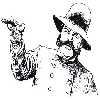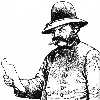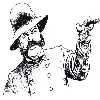About myself and my view of Military History

|
a) My Life:
I was born in 1947 in Liverpool, England, and at a young age I was sometimes taken to historical sites in my father's native Scotland (pictured on left). Later I went on to university at Corpus Christi College, Oxford. In 1968 I wrote an undergraduate thesis on French assault tactics of the Revolutionary and Napoleonic Wars, and in 1976 I completed my doctorate on 'Military Thought in the French Army 1815-51' (finally published in 1989). Meanwhile in 1973 I had taken up a lecturing post in War Studies at the Royal Military Academy Sandhurst (ie the British equivalent to West Point). I married in 1976, with an Anglo-French son born in 1979, who has now been of quite essential and invaluable help in constructing this web site! In 1989 I Left Sandhurst to become a freelance writer and publisher (of 'Fieldbooks' and 'Paddy Griffith Associates' books). I soon moved to Nuneaton, which is geometrically the centre of England, and then in 1999 to Manchester, which is pretty central in some other ways.
While I was at Sandhurst I ran the wargame club (See 'A Book of Sandhurst Wargames'), as well as a series of very large wargames (or 'megagames') (involving up to 80 people). In 1980 I went on to set up an international society for the reform of hobby wargames, 'Wargame Developments', which is still running today.
|
b) Military History:
My interest in military history began with the 1950s craze for Cowboys & Indians (I saw Roy Rogers live in Liverpool); but by the early 1960s I had visited some battlefields in Spain and, inspired by Tom Pickard my history teacher, had become fascinated with Wellington's Peninsular War. This led me to Napoleon's army and then to the experiences of its surviving members during the decades after Waterloo. In the 1840s the French invented new tactics, although the biggest war in which they would be used turned out to be the American Civil War. This is what I looked at in the early 1980s, from which my logical next step was to study the Great War of 1914-18. Meanwhile my work at Sandhurst on the wars after 1919 had been helping me to form many opinions about contemporary warfare, so I wrote some books about that as well.
In all this the centre of my interest normally lay with low level tactics, or the way in which one small group of frightened men is expected to use its weapons against another small group of equally-frightened men. Not only what is expected to happen: but also what actually does happen, which is usually very far from the same thing. What is fascinating to me is the discrepancy between the way tactics and weapons are supposed to work (according to drill manuals or arms manufacturers' brochures), and the way they really do work in practice.

My first major look at all this came in 'Forward Into Battle'. The first edition (Antony Bird, Chichester 1981: ISBN 0 907319 01 7) consisted of four revisionist essays in tactical history, 1808-1973:-
|
i) Wellington's infantry normally fought off French attacks by bayonet counter-charges rather than (as is often claimed) by protracted firing. Sustained firefights as at Albuera actually represented a failure of tactics, rather than a preferred technique, whereas it seems that what usually defeated the French was a sudden counter-attack, with little shooting but much cheering and much brandishing of the bayonet. Thus the result turned out to depend on psychology rather than technology, which is a theme that can be traced through the warfare of every age.
ii) 'The empty battlefield' of dispersed skirmishers had always co-existed with massed bayonet tactics, and was not (as is often claimed) created by the arrival of powerful new weapons in the 1850s and / or 1880s. Conversely the massed bayonet tactics themselves never became obsolete in the 19th century, and survived into at least the early part of the Great War.
iii) The tank delivered considerably fewer tactical benefits, during two world wars, than its propagandists would have us believe. Conversely the infantry attack did not become impossible in the 20th century, but merely changed its form into what are sometimes called 'stormtroop tactics'.
|

|
iv) The US forces in Vietnam (contrary to common perceptions) were too few to do the job properly, and often lacked sufficient firepower where it mattered. In jungle terrain light US company-sized units often found themselves isolated, outnumbered and outgunned. Only in 1968 had their numbers, technique and armament reached satisfactory levels - and the war on the ground was all but won - but by then the political war had already been lost.

|
Perhaps bizarrely (in view of what I say about military manuals), 'Forward Into Battle' helped to inspire the writing of the US Army's 1993 operational doctrine, Field Manual (FM) 100-5, whose author, General Frederick M Franks jr (TRADOC), 'paid doctrinal homage to two classic military theorists, Sun Tzu and Clausewitz and to the contemporary British writer Paddy Griffith' (John L Romjue, 'American Army Doctrine for the Post-Cold War', p.109).
The second edition of 'Forward Into Battle' appeared in 1990 (Crowood Press, Swindon: ISBN 1 85223 075 4; and Presidio Press, Novato CA 1991: ISBN 0 89141 413 4; also a later paperback). It had the same basic text as the first edition, but with extra new sections in each chapter: A discussion of the statistics of Napoleonic firepower and the Battle of New Orleans; Material on the American Civil War and on the French tactics of August 1914; Montgomery's 'Corps de Chasse' and the Soviet 'Operational Manoeuvre Group' in the armoured warfare of 1942-5; and the obsessions of the American post-Vietnam 'Rambo generation'. The end point of the book was extended from 1973 to 'the near future', although it was all too rapidly overtaken by the events of the 1991 Gulf War.
|
As soon as one stops believing everything that is written in drill manuals and arms industry advertisements, one immediately starts to find problems with the descriptions of warfare that have been propagated by normally-respected historians. Thus Sir Charles Oman wrote the best-ever book about the Peninsular War, but he sadly misinterpreted the firefights of column vs line in 1808. This was because he was excessively influenced by the mathematics of 'crossing the T' in the debate about naval tactics in 1900. Then again, the likes of JFC Fuller and Basil 'Liddell' Hart found twisted personal motives for condemning the professional military wisdom of their own age. This led them into mistakenly identifying a revolution in firepower during the American Civil War; a tank revolution in 1917, and a strategic bombing revolution in the 1930s. How wrong they were! How wrong the defence correspondents of the Daily Telegraph ALWAYS are!






